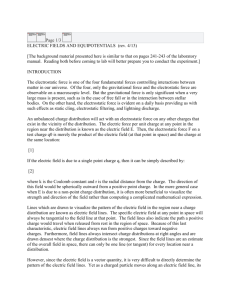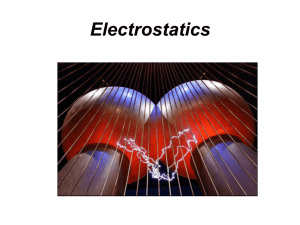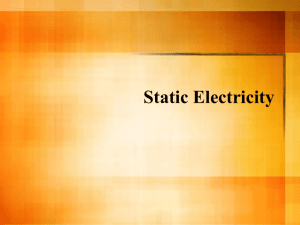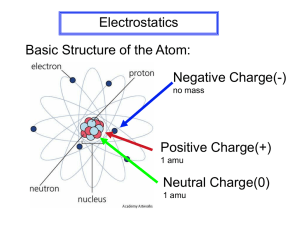Electric potential Energy
advertisement
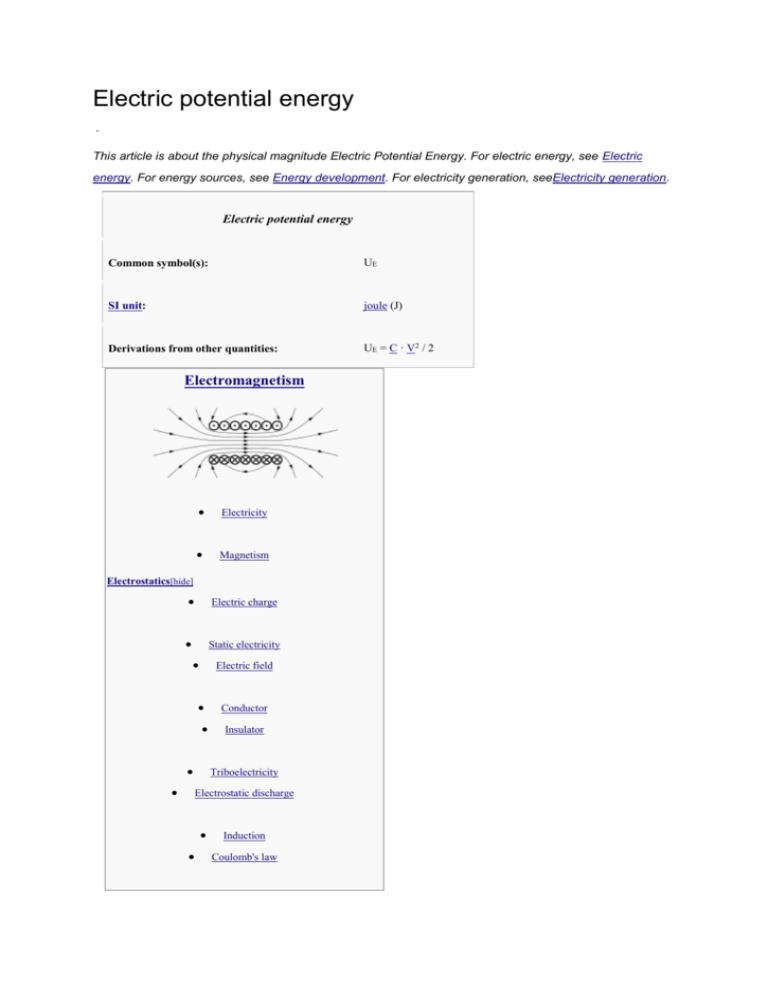
Electric potential energy . This article is about the physical magnitude Electric Potential Energy. For electric energy, see Electric energy. For energy sources, see Energy development. For electricity generation, seeElectricity generation. Electric potential energy Common symbol(s): UE SI unit: joule (J) Derivations from other quantities: UE = C · V2 / 2 Electromagnetism Electricity Magnetism Electrostatics[hide] Electric charge Static electricity Electric field Conductor Insulator Triboelectricity Electrostatic discharge Induction Coulomb's law Gauss's law Electric flux / potential energy Electric dipole moment Polarization density Magnetostatics[show] Electrodynamics[show] Electrical network[show] Covariant formulation[show] Scientists[show] V T E Electric potential energy, or electrostatic potential energy, is a potential energy (measured in joules) that results from conservative Coulomb forces and is associated with the configuration of a particular set of point charges within a defined system. An object may have electric potential energy by virtue of two key elements: its own electric charge and its relative position to other electrically charged objects. The term "electric potential energy" is used to describe the potential energy in systems with timevariant electric fields, while the term "electrostatic potential energy" is used to describe the potential energy in systems with time-invariant electric fields. Definition The electrostatic potential energy can be defined in terms of the electric field or in terms of the electric potential. Both definitions are completely valid and can be used equally. The electrostatic potential energy, UE, of one point charge q at position r in the presence of an electric field E is defined as the negative of the work Wdone by the electrostatic force to bring it from the reference position rref[note 1] to that position r.[1][2]:§25-1[note 2] , where E is the electrostatic field and ds is the displacement vector in a curve from the reference position rref to the final position r. The electrostatic potential energy can also be defined from the electric potential as follows: The electrostatic potential energy, UE, of one point charge q at position r in the presence of an electric potential is defined as the product of the charge and the electric potential. , where is the electric potential generated by the charges, which is a function of position r. Units The SI unit of electric potential energy is the joule (named after the English physicist James Prescott Joule). In the CGS system the erg is the unit of energy, being equal to 10−7 J. Alsoelectronvolts may be used, 1 eV = 1.602×10−19 J. Electrostatic potential energy of one point charge[edit source | editbeta] One point charge q in the presence of one point charge Q A point charge q in the electric field of another charge Q. The electrostatic potential energy, UE, of one point charge q at position r in the presence of a point charge Q, taking an infinite separation between the charges as the reference position, is: , where is Coulomb's constant, r is the distance between the point charges q & Q, and q & Q are the signed values of the charges (not the modules of the charges. For example, an electron would have a negative value of charge when placed in the formula). The following outline of proof states the derivation from the definition of electric potential energy and Coulomb's law to this formula. [show]Outline of proof One point charge q in the presence of n point charges Qi Electrostatic potential energy of q due toQ1 and Q2 charge system: The electrostatic potential energy, UE, of one point charge q in the presence of n point charges Qi, taking an infinite separation between the charges as the reference position, is: , where is Coulomb's constant, ri is the distance between the point charges q & Qi, and q & Qi are the signed values of the charges. Electrostatic potential energy stored in a system of point charges The electrostatic potential energy UE stored in a system of N charges q1, q2, ..., qN at positions r1, r2, ..., rN respectively, is: ( 1 , where, for each i value, Φ(ri) is the electrostatic potential due to all point charges except the one at ri,[note 3] and is equal to: ) , where rij is the distance between qj and ri. [show]Outline of proof Energy stored in a system of one point charge The electrostatic potential energy of a system containing only one point charge is zero, as there are no other sources of electrostatic potential against which an external agent must do work in moving the point charge from infinity to its final location. Energy stored in a system of two point charges Consider bringing a point charge, q, into its final position in the vicinity of a point charge, Q1. The electrostatic potential Φ(r) due to Q1 is Hence we obtain, the electric potential energy of q in the potential of Q1 as where r1is the separation between the two point charges. Energy stored in a system of three point charges The electrostatic potential energy of a system of three charges should not be confused with the electrostatic potential energy of Q1 due to two charges Q2 and Q3, because the latter doesn't include the electrostatic potential energy of the system of the two charges Q2 and Q3. The electrostatic potential energy stored in the system of three charges is: [show]Outline of proof Energy stored in an electrostatic field distribution The energy density, or energy per unit volume, , of the electrostatic field of a continuous charge distribution is: [show]Outline of proof Energy in electronic elements The electric potential energy stored in a capacitor is UE=½ CV2 Some elements in a circuit can convert energy from one form to another. For example, a resistor converts electrical energy to heat, this is known as the Joule effect. A capacitor stores it in its electric field. The total electric potential energy stored in a capacitor is given by where C is the capacitance, V is the electric potential difference, and Q the charge stored in the capacitor. Notes 1. ^ The reference zero is usually taken to be a state in which the individual point charges are very well separated ("are at infinite separation") and are at rest. 2. ^ Alternatively, it can also be defined as the work W done by the an external force to bring it from the reference position rref to some position r. Nonetheless, both definitions yield the same results. 3. ^ The factor of one half accounts for the 'double counting' of charge pairs. For example, consider the case of just two charges.
